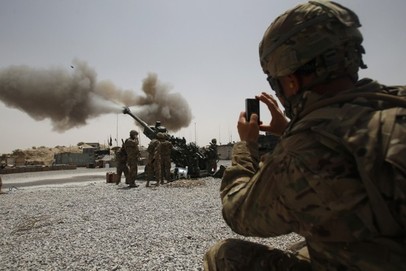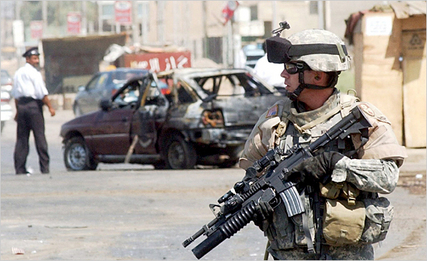MOSUL, Iraq — The soldiers from the Iraqi army’s 2nd Division gawked at it, posed for pictures with it, rubbed their hands on it and then stood in crisp form when U.S. troops introduced them last week to their newest weapon.

In a two-story warehouse on the grounds of an old Iraqi ammunition storage site stood a confidence-builder for the beleaguered Iraqi army: an M198 howitzer cannon. For Iraqi soldiers yearning for people’s respect, the arrival of American-made artillery was a big step toward building the pride that is essential to any effective army.
“This is so much technology, powerful,” said Ali Hadi, 42, a specialist in his division’s new artillery regiment. “Things are going to get better.’’
The new 155mm guns are part of a multibillion-dollar effort to upgrade the Iraqi army ahead of the scheduled withdrawal of the remaining U.S. forces by Dec. 31. Among growing shipments of American-made weapons to Iraq are M1A1 Abrams tanks, M113 armored personnel carriers and patrol boats.
In a country where eager soldiers still believe a bigger weapon makes a bigger man, the wiping out of its artillery capability in the U.S.-led 2003 invasion has never sat well with Iraqi commanders. Until now, said Col. Alaa A. Abdalrida, of the 2nd Division, “without the Americans, I couldn’t defend the country.”
The new artillery, Abdalrida said, “will ensure the Iraqi army is no less than other armies.”
Under Saddam Hussein, Iraq’s artillery capabilities were among the best in the Middle East, forming the backbone of its army’s battle plan in the war with Iran in the 1980s. In the run-up to the 1991 Persian Gulf War and the 2003 invasion, U.S. military planners feared that Hussein would arm his artillery with chemical or biological warheads, concerns that later proved unfounded.
Ultimately, Hussein’s artillery was no match for U.S. warplanes, tanks and artillery, and much of Iraq’s heavy ordnance was destroyed in the 2003 invasion. What remained was decommissioned, fell into disrepair or lacked ammunition for use by the new Iraqi army, according to U.S. and Iraqi military officials.
The post-Hussein Iraqi army has instead relied on short- and medium-range mortars. Because Iraq still lacks warplane and missile capabilities, experts have voiced doubts that it could repel an invasion without U.S. help.
The first howitzers arrived this spring, and soldiers from the U.S. Army’s 25th Infantry Division have finished training Iraqi soldiers in Diyala, east of Baghdad, on how to operate the cannons. The field artillery unit of the U.S. Army’s 1st Cavalry Division, based in Fort Hood, Tex., began the training here in northern Iraq on Monday, at the Ghuzali Eagle Training Center.
“They will now basically have what we have,” said Lt. Rory R. Garcia of the 1st Cavalry Division field artillery unit, which is training Hadi’s regiment in how to operate and maintain the weapons.
American military officials said the U.S. government withheld some features of the howitzers considered classified. But they said the 42-foot-long, computer-guided weapons will cover up to 13 miles, more than triple the range of Iraq’s largest mortar.
The weapon has a “kill zone” of 100 feet, and injury-causing shrapnel will probably fly out to 500 feet, said Sgt. Bobby Brewster of the 1st Cavalry Division’s artillery unit.
On the first and second day of training last week, the 40 Iraqi soldiers were divided into groups to learn how to target and fire the weapons. Like any good lesson plan, the basics came first.
“If one or both tires are missing, you cannot operate this system,” a U.S. soldier, speaking through an interpreter, told the Iraqi soldiers gathered around him.
One important lesson for the Iraqi army, according to Garcia and Brewster, is that a well-trained soldier using a M198 howitzer will be far more effective than Hussein’s army was in its use of artillery.
Although Hussein amassed as many as 3,000 artillery pieces, many from Russia, U.S. military officials say soldiers in the old Iraqi army lacked the training and technical support needed to use the weapons effectively.
“We would see a round go off far away, then they would readjust, and it would go off even farther away. We would counter-fire once and then hear no more,” recalled Brewster, who took part in artillery battles during the 2003 invasion.
The goal, Brewster and Garcia said, is to train Iraq’s new army artillery units to deliver the same precision.
“This is so much technology, powerful,” said Ali Hadi, 42, a specialist in his division’s new artillery regiment. “Things are going to get better.’’
The new 155mm guns are part of a multibillion-dollar effort to upgrade the Iraqi army ahead of the scheduled withdrawal of the remaining U.S. forces by Dec. 31. Among growing shipments of American-made weapons to Iraq are M1A1 Abrams tanks, M113 armored personnel carriers and patrol boats.
In a country where eager soldiers still believe a bigger weapon makes a bigger man, the wiping out of its artillery capability in the U.S.-led 2003 invasion has never sat well with Iraqi commanders. Until now, said Col. Alaa A. Abdalrida, of the 2nd Division, “without the Americans, I couldn’t defend the country.”
The new artillery, Abdalrida said, “will ensure the Iraqi army is no less than other armies.”
Under Saddam Hussein, Iraq’s artillery capabilities were among the best in the Middle East, forming the backbone of its army’s battle plan in the war with Iran in the 1980s. In the run-up to the 1991 Persian Gulf War and the 2003 invasion, U.S. military planners feared that Hussein would arm his artillery with chemical or biological warheads, concerns that later proved unfounded.
Ultimately, Hussein’s artillery was no match for U.S. warplanes, tanks and artillery, and much of Iraq’s heavy ordnance was destroyed in the 2003 invasion. What remained was decommissioned, fell into disrepair or lacked ammunition for use by the new Iraqi army, according to U.S. and Iraqi military officials.
The post-Hussein Iraqi army has instead relied on short- and medium-range mortars. Because Iraq still lacks warplane and missile capabilities, experts have voiced doubts that it could repel an invasion without U.S. help.
The first howitzers arrived this spring, and soldiers from the U.S. Army’s 25th Infantry Division have finished training Iraqi soldiers in Diyala, east of Baghdad, on how to operate the cannons. The field artillery unit of the U.S. Army’s 1st Cavalry Division, based in Fort Hood, Tex., began the training here in northern Iraq on Monday, at the Ghuzali Eagle Training Center.
“They will now basically have what we have,” said Lt. Rory R. Garcia of the 1st Cavalry Division field artillery unit, which is training Hadi’s regiment in how to operate and maintain the weapons.
American military officials said the U.S. government withheld some features of the howitzers considered classified. But they said the 42-foot-long, computer-guided weapons will cover up to 13 miles, more than triple the range of Iraq’s largest mortar.
The weapon has a “kill zone” of 100 feet, and injury-causing shrapnel will probably fly out to 500 feet, said Sgt. Bobby Brewster of the 1st Cavalry Division’s artillery unit.
On the first and second day of training last week, the 40 Iraqi soldiers were divided into groups to learn how to target and fire the weapons. Like any good lesson plan, the basics came first.
“If one or both tires are missing, you cannot operate this system,” a U.S. soldier, speaking through an interpreter, told the Iraqi soldiers gathered around him.
One important lesson for the Iraqi army, according to Garcia and Brewster, is that a well-trained soldier using a M198 howitzer will be far more effective than Hussein’s army was in its use of artillery.
Although Hussein amassed as many as 3,000 artillery pieces, many from Russia, U.S. military officials say soldiers in the old Iraqi army lacked the training and technical support needed to use the weapons effectively.
“We would see a round go off far away, then they would readjust, and it would go off even farther away. We would counter-fire once and then hear no more,” recalled Brewster, who took part in artillery battles during the 2003 invasion.
The goal, Brewster and Garcia said, is to train Iraq’s new army artillery units to deliver the same precision.


 RSS Feed
RSS Feed